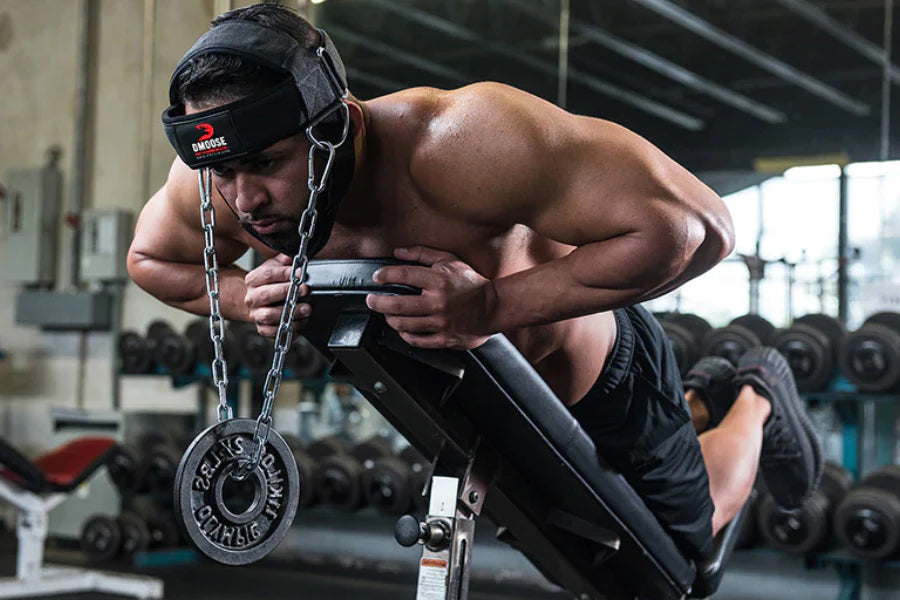Gather 'round, folks, because we're about to embark on an adventure with you holding your head high! We're delving into the intriguing realm of building a solid neck, where neck harnesses reign supreme and neck muscles become the stuff of legends.
You might wonder, "What's the big deal about a strong neck?" Well, my friends, let me tell you, a strong neck is like the unsung hero of the body. It's not just about looking like a Greek god or goddess with a neck that could rival Hercules himself (although that's a pretty tempting bonus).
No, no, no. A robust neck is a powerhouse of awesomeness that holds the key to overall athletic performance, injury prevention, and maintaining a posture that says, "I own this room."
Picture this: You're engaged in your favourite sport, wrestling, football, or even a friendly game of dodgeball. Your neck muscles, strong and resilient, provide stability and support needed to withstand the impact, dodge those flying projectiles, and keep your head in the game - quite literally.
But that's not all, folks! A strong neck is your knight in shining armour when it comes to preventing injuries. Think about when you turned your head too quickly or accidentally jolted your neck during a workout.
Ouch! With a fortified neck, those incidents become a thing of the past, as your robust muscles act as a cushion, protecting you from unnecessary pain and discomfort.
And let's remember the power of posture. A strong neck stood tall, defying the forces of gravity and slumped shoulders. It's like wearing an invisible cape that says, "I am confident, I am poised, and I am ready to take on the world!"
Now, my eager learners, it's time to unveil the secrets of neck training. Our focus here is on practical neck exercises and the incredible benefits that await those who embrace the neck harness.
This marvellous gadget is designed to target those neck muscles precisely, giving them a workout they'll never forget. Think of it as a personal trainer for your neck, sculpting those muscles into a work of art.
Related Article: How to Use Neck Head Harness
Anatomy of the Neck Muscles
The neck is home to fascinating muscles that work together to provide stability, mobility, and support. Let's take a closer look at some key players in the anatomy of the neck.
First, we have the sternocleidomastoid, a prominent muscle that runs diagonally across the front of the neck. It connects the sternum and clavicle to the mastoid process of the skull and allows for the rotation and tilting of the head.
Next, we have the trapezius, a large muscle that spans from the base of the skull down to the upper back and shoulders. It helps with head and neck movement, shoulder elevation, and retraction.
Lastly, we have the splenius capitis, a deep muscle that runs along the back of the neck and attaches to the skull. It assists in extending and rotating the head. When solid and well-conditioned, these muscles contribute to good posture and stability.
On the other hand, weak neck muscles can lead to postural imbalances, such as forward head posture or rounded shoulders, which may result in neck pain, decreased range of motion, and reduced stability.
Understanding the anatomy of the neck muscles can help us appreciate their importance in maintaining proper posture and stability for overall neck health and function.
Related Article: 4 Neck Strengthening Exercises for Boxers and Athletes
Why Strong Neck Muscles Matter
Strong neck muscles are vital in supporting the head, stabilizing the spine, and reducing the risk of neck injuries. Here are some advantages of having strong neck muscles.
Support and Stability for the Head and Spine
Strong neck muscles are crucial in supporting and stabilizing the head and spine. The neck muscles, including the sternocleidomastoids, trapezius, and deep cervical flexors, work together to maintain proper head alignment atop the spine.
This alignment is essential for optimal posture and reducing strain on the neck. By supporting the head's weight, strong neck muscles help distribute the load evenly and prevent excessive stress on the neck vertebrae, discs, and surrounding structures.
Reducing the Risk of Neck Injuries
One significant benefit of having strong neck muscles is their ability to reduce the risk of neck injuries. Engaging in activities with a high risk of head impacts, such as contact sports or combat sports, increases the neck's vulnerability.
However, well-developed neck muscles act as a natural protective mechanism. They provide stability and act as shock absorbers, effectively dissipating and minimizing the forces that could lead to injury.
Strong neck muscles also contribute to improved neck flexibility and range of motion, allowing for better control and decreasing the likelihood of sudden, uncontrolled movements that may result in injury.
You can incorporate DMoose Post Workout Supplement in your routine to help you maximize your gains and aid in recovery after intense training sessions.
This specially formulated powder is packed with high-quality ingredients designed to replenish your body's depleted energy stores and support muscle recovery. With a balanced ratio of carbohydrates and protein, DMoose Post Workout Powder provides the essential nutrients your muscles need to repair and grow.
Importance for Athletes in High-Impact Sports
Athletes involved in high-impact sports greatly benefit from having strong neck muscles. The demands of contact sports, such as football, rugby, or wrestling, place significant stress on the neck due to tackles, collisions, and grappling maneuvers.
Similarly, combat sports like boxing, MMA, or martial arts involve deliberate strikes to the head and neck region. A strong neck becomes a critical asset in these sports, enhancing stability, resistance to impact, and overall injury resilience.
By incorporating targeted neck strengthening exercises into their training regimen, athletes can fortify their neck muscles, improving their ability to withstand and minimize the effects of forceful impacts.
Enhancing Performance and Athletic Potential
Beyond injury prevention, strong neck muscles contribute to improved athletic performance. A robust neck allows athletes to maintain proper posture, essential for maximizing power, agility, and overall body control.
In sports that require rapid head movements, such as soccer or basketball, a strong neck enables quick and accurate changes in visual focus. Moreover, a well-developed neck enhances body awareness, proprioception, and balance, improving coordination and performance across various athletic endeavours.
Related Article: 7 Quick and Easy Neck Exercises That Can Help You Completely Get Rid of the Double Chin You Hate
Neck Exercises Without Equipment
You don't always need fancy equipment to get results regarding neck training. In this guide, we explore a variety of practical neck exercises that can be done without specialized equipment.
Neck Flexion
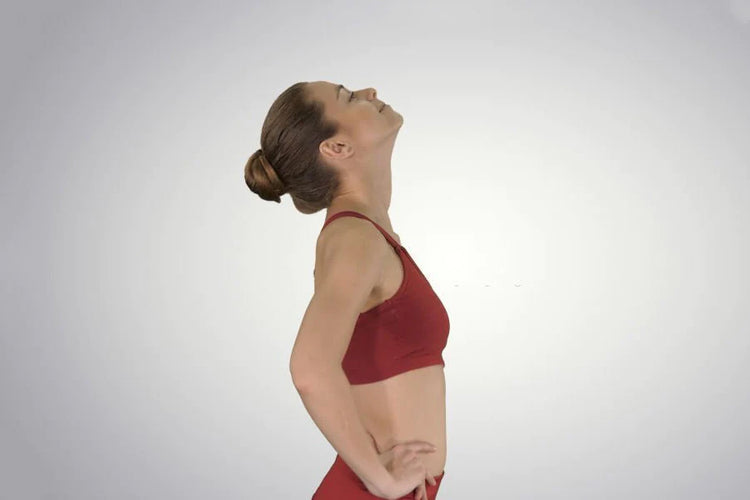
Neck flexion is a valuable exercise that targets the front muscles of your neck. By engaging these muscles, you can enhance neck strength and stability. Isometric exercises like neck flexion are beneficial for developing muscle strength and endurance without excessive strain on the joints. Strong neck muscles contribute to better posture, reduced risk of injury, and improved overall neck health.
Gradually increasing the intensity of your neck flexion exercises and maintaining proper form can help you maximize the benefits and safely challenge your neck muscles. Incorporating neck flexion into your fitness routine can be a great way to improve neck strength and stability for better overall well-being.
To Do It:
- Stand and straighten your spine.
- Bend your head downwards.
- Now, try to touch your chin on your chest without opening your mouth.
- Return to the starting position.
Neck Extension
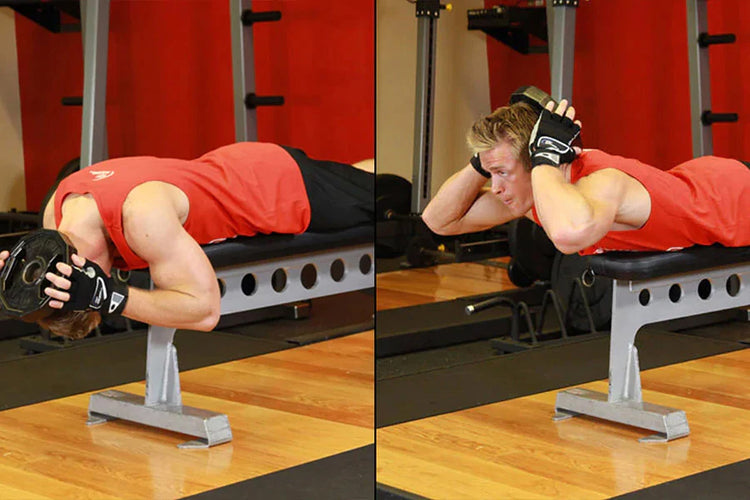
Neck extension is a valuable exercise that targets the muscles at the back of your neck, promoting strength and stability. By interlacing your fingers behind your head and gently applying pressure as you tilt your head backward, you engage the muscles responsible for extending your neck.
This exercise helps to improve neck strength and posture while reducing the risk of strain and injury. Gradually increasing the intensity of your neck extension exercises and maintaining proper form is essential for maximizing the benefits and safely challenging your neck muscles.
Incorporating neck extensions into your fitness routine can contribute to a more muscular, stable neck, enhancing overall well-being.
To Do It:
- Lie down on a surface with your face facing the floor
- Keep your hands by your sides
- Lift your chin towards the ceiling
- Return to the original position
Lateral Flexion

Lateral flexion is a beneficial exercise that targets the muscles on the sides of your neck, promoting flexibility, strength, and stability. You gently tilt your head towards the opposite shoulder and engage the lateral muscles, including the sternocleidomastoid and scalene muscles.
This exercise helps improve the range of motion in your neck and enhances overall neck flexibility. Lateral flexion can also contribute to better posture and reduce the risk of muscle imbalances.
Remember to perform this exercise with controlled movements, avoiding sudden jerks or excessive force. Gradually increasing the intensity and incorporating lateral flexion into your fitness routine can help strengthen and maintain a well-balanced neck, promoting optimal neck health and overall well-being.
To Do It:
- Stand up tall and straight.
- Tilt your head sideways.
- Try to touch the ears to the shoulder.
- Make sure you keep your shoulders straight throughout.
- Return to the original position and repeat on the other side.
Remember to perform these exercises with control and avoid any sudden or jerky movements. Start with gentle resistance and gradually increase the intensity as your neck muscles become stronger and more conditioned.
Stop and consult with a healthcare professional if you experience any pain or discomfort during the exercises. Regularly incorporating these exercises into your routine can help strengthen and stabilize your neck, improving posture and reducing the risk of strain and injury.
Benefits of Using a Neck Harness

Incorporating a neck harness into your training routine offers numerous benefits, including targeted resistance, progressive overload, convenience, versatility, and the ability to isolate specific neck muscles. This specialized equipment will strengthen your neck, improve athletic performance, and promote optimal neck health.
Specialized Equipment for Neck Training
The neck harness is specialized equipment designed specifically for neck exercises. Unlike generic training equipment, the neck harness is engineered to provide optimal support and stability while targeting the neck muscles. Its unique design ensures that the resistance is evenly distributed, reducing the risk of strain or injury.
Targeted Resistance and Progressive Overload
One of the key advantages of using a neck harness is the ability to apply targeted resistance to the neck muscles. With the harness securely attached, you can perform various exercises such as neck flexion, extension, lateral flexion, and rotation with controlled resistance.
This targeted approach allows you to overload the neck muscles progressively, leading to strength gains and improved muscle definition.
Convenience
A neck harness is a convenient tool for neck training. It is compact, lightweight, and portable, making it easy to use at home, in the gym, or even while travelling. You can incorporate neck exercises into your routine without bulky equipment.
Versatility
The neck harness offers versatility in terms of resistance. It can be used with different weights, such as weight plates, kettlebells, or resistance bands, allowing you to adjust the intensity according to your fitness level and goals.
Specific Muscle Targeting
The neck harness enables you to isolate and target specific neck muscles. By adjusting the direction and angle of the resistance, you can focus on strengthening muscles like the sternocleidomastoid, trapezius, and splenius capitis, which play a vital role in neck stability and overall posture.
Enhanced Neck Strength and Stability
Regular use of a neck harness can lead to enhanced neck strength and stability. Strong neck muscles are crucial for supporting the head's weight, maintaining proper posture, and reducing the risk of neck injuries.
With a well-developed neck, you can improve your athletic performance, especially in sports that involve physical contact or activities with a high risk of head impact.
Safety Considerations
Safety should always be a top priority in any form of physical training. This is especially true when training the neck, as it is a delicate and vulnerable body area. Understanding and implementing proper safety considerations can help minimize the risk of strain, injury, and discomfort during neck exercises.
Proper Form and Gradual Progression
To ensure safety during neck training, it is crucial to prioritize proper form and technique. Maintain a neutral spine, engage the core muscles, and avoid sudden or jerky movements.
Start with lighter resistance or weights and gradually increase the intensity as your neck muscles become more robust and adapt to the exercises. Progressing gradually allows for better muscle development while minimizing the risk of strain or injury.
Avoiding Excessive Strain or Injury
While performing neck exercises, listening to your body and avoiding excessive strain is essential. Avoid excessive weight or resistance that could compromise your form or cause unnecessary stress on the neck muscles.
Additionally, avoid any exercises that cause sharp pain or discomfort. Pay attention to your body's signals and modify or stop the exercise to prevent injury.
Consultation With a Professional or Trainer
If you have any pre-existing neck conditions, it is strongly recommended to consult with a professional or a certified trainer before starting neck training.
They can provide guidance specific to your needs, assess your condition, and offer exercise modifications or alternatives to ensure your safety and prevent the worsening of any current issues. Their expertise will help you tailor your neck training program to your circumstances.
Listen to Your Body
Always listen to your body and respect its limits. If you experience any pain, discomfort, dizziness, or unusual sensations during neck exercises, stop immediately and seek guidance from a healthcare professional. Your safety and well-being are paramount, and it's important to prioritize them above all else.
Related Article: How to Get a Stronger Neck?
Benefits Beyond Strength
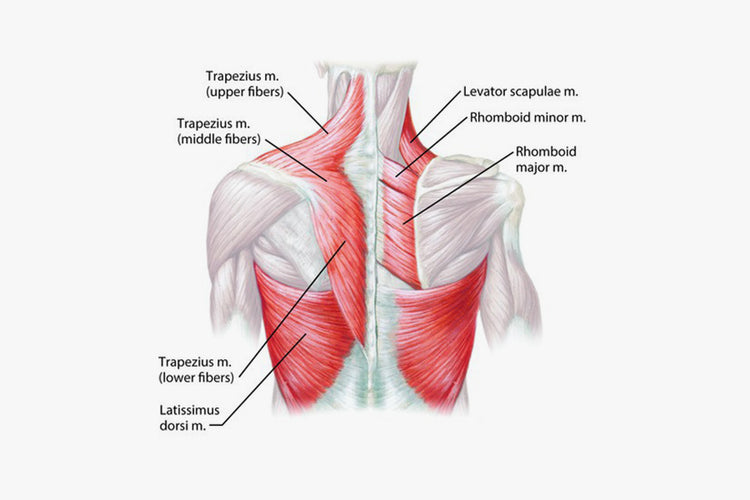
By prioritizing neck training, you can promote better overall body alignment, maintain a healthy spine, and enjoy a more comfortable and pain-free neck and upper back. Here are some benefits of training for the neck beyond strength.
Correlation Between Strong Neck, Good Posture, and Reduced Neck Pain
A strong neck plays a vital role in maintaining good posture beyond aesthetics. The neck muscles support the head and help align the spine properly.
By strengthening these muscles, you can improve your posture and reduce the risk of developing neck pain or discomfort. Strong neck muscles provide stability, allowing the head to be correctly aligned over the shoulders, reducing strain on the neck and upper back.
Prevention of Common Neck Injuries
A strong neck can also help prevent common neck injuries, such as whiplash. Whiplash occurs when the head is suddenly jolted backward or forward, causing strain and potential damage to the neck.
With well-developed neck muscles, the neck becomes more resilient and better equipped to withstand sudden forces. Strengthening the neck can provide a protective buffer, reducing the likelihood of whiplash and other similar injuries.
Positive Impact on Overall Body Alignment and Spinal Health
Strong neck muscles contribute to improved overall body alignment and spinal health. The neck is a crucial part of the kinetic chain, connecting the head to the rest of the body.
When the neck is weak or imbalanced, it can affect the alignment of the entire spine, leading to issues such as poor posture, muscle imbalances, and an increased risk of injuries. Strengthening the neck promotes better body alignment and spinal stability, positively impacting your musculoskeletal health.
Incorporating Neck Exercises Into a Routine
Regarding neck training, it's essential to integrate exercises into a well-rounded workout routine. Consider the following recommendations to incorporate neck exercises into your regimen effectively:
Frequency and Sets
For beginners, start with 2-3 sessions per week, allowing for rest days in between to promote recovery. Perform 2-3 sets of each exercise, focusing on maintaining proper form and technique.
Intermediate and advanced individuals can gradually increase the frequency to 3-4 weekly sessions, incorporating more challenging variations and additional sets.
Gradual Progression and Listening to the Body
It's important to progress gradually to avoid overexertion or strain. Start with lighter resistance or weights and gradually increase the intensity as your neck muscles become more robust and adapt to the exercises.
Listen to your body's signals and adjust the intensity or range of motion accordingly. Reduce the load or seek professional guidance if you experience pain or discomfort.
Sample Workout Routine
A well-designed workout routine is key to achieving fitness goals and maintaining overall health. Incorporating various exercises targeting different muscle groups ensures a balanced and comprehensive approach to fitness.
A sample workout routine provides structure and guidance, helping individuals establish a consistent exercise regimen.
Beginner
Neck Flexion: 2 sets of 10-12 repetitions
Neck Extension: 2 sets of 10-12 repetitions
Lateral Flexion: 2 sets of 10-12 repetitions on each side
Neck Rotation: 2 sets of 10-12 repetitions on each side
Intermediate
Neck Flexion: 3 sets of 12-15 repetitions
Neck Extension: 3 sets of 12-15 repetitions
Lateral Flexion: 3 sets of 12-15 repetitions on each side
Neck Rotation: 3 sets of 12-15 repetitions on each side
Advanced
Neck Flexion: 4 sets of 15-20 repetitions
Neck Extension: 4 sets of 15-20 repetitions
Lateral Flexion: 4 sets of 15-20 repetitions on each side
Neck Rotation: 4 sets of 15-20 repetitions on each side
Remember to prioritize proper form and technique throughout the workout. Take breaks between sets to rest and recover. Gradually increase the resistance or intensity as you progress. It's crucial to be mindful of your body's responses and adjust the workout accordingly. Consulting with a fitness professional can provide valuable guidance and ensure that your neck exercises are integrated effectively and safely into your overall workout routine.
DMoose Neck Harness
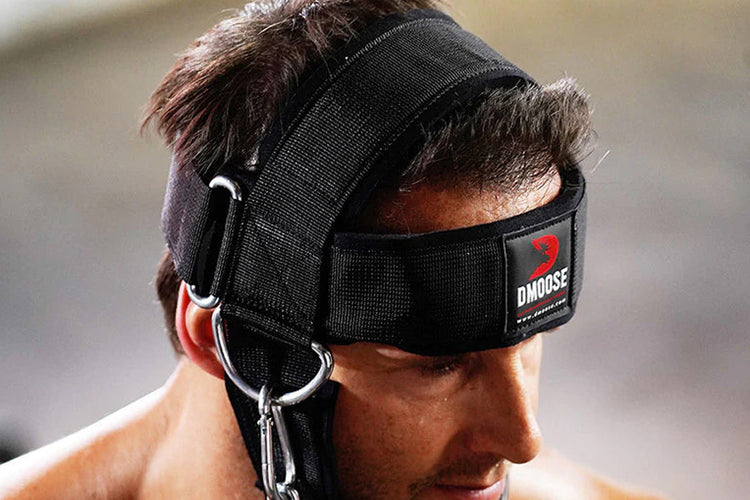
The DMoose Neck Harness is a game-changer when it comes to neck training. This specialized equipment is designed to provide optimal resistance and support for strengthening the neck muscles.
With its durable construction and adjustable strap, the DMoose Neck Harness offers a secure and comfortable fit for users of all fitness levels. Whether you're an athlete looking to enhance performance or improve neck strength and posture, this neck harness is a reliable companion.
Its versatility allows for various exercises, including flexion, extension, lateral flexion, and rotation, targeting different neck areas. The DMoose Neck Harness is practical and built to last, ensuring long-term use and effective results.
Take your neck training to the next level with the DMoose Neck Harness and experience the benefits of a stronger and more resilient neck.
Conclusion
Exploring the world of neck training and the benefits of using a neck harness, we have delved into the significance of building a strong neck for athletic performance, injury prevention, and posture.
By incorporating targeted neck exercises into our fitness routines, we can strengthen the neck muscles, support the spine, and reduce the risk of neck-related issues.
The neck harness is valuable for providing resistance and promoting progressive overload, allowing for balanced development and enhanced neck strength. Additionally, the convenience and versatility of a neck harness offer the ability to target specific neck muscles effectively.
However, it is crucial to prioritize safety considerations, maintain proper form, and progress gradually to ensure a safe and effective neck training experience. By embracing the benefits of a neck harness, we can unlock the potential for a more muscular neck, improved posture, and overall well-being.









